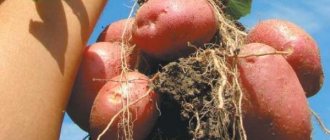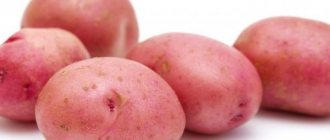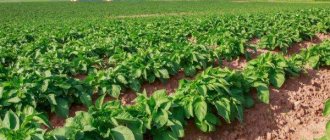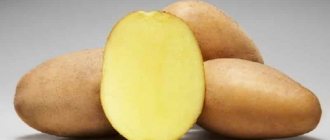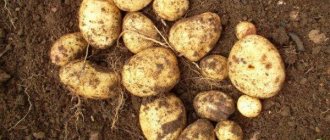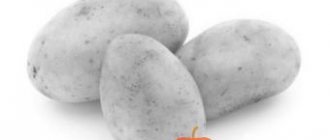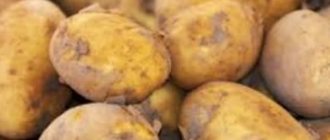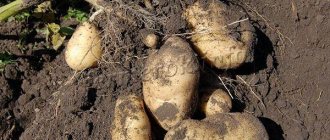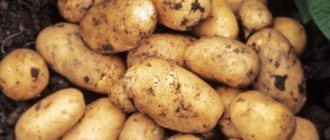History of the origin of the potato variety "Ariel":
The Ariel variety was bred by Dutch breeding scientists. How he appeared in our country:
- The initiator of its spread in post-Soviet countries was the Dutch company (Agrico), created in 1973;
- Like many other vegetable varieties produced in Holland, Ariel underwent the state variety testing procedure;
- In 2011, the variety was included in the State Register of Breeding Achievements approved for use in the Russian Federation.
Potato dig:
Impala
Impala is another popular early harvest potato variety. It is the result of the work of Dutch breeders. Impala can be called a super early variety, since the harvest can be harvested within 1.5 months after the appearance of the first shoots. But it is worth mentioning that the ripening time largely depends on climatic conditions. In a short time, a tall and powerful bush is formed. The average yield is 270 centners per hectare. The vegetable has good taste. Yellow potatoes do not change color when cooked.
Impala is grown in almost all regions of Russia, but it is most popular in the Leningrad region and the Moscow region.
We have reviewed the descriptions of those varieties that are not difficult to grow in Russia. But these are not all good varieties. Such varieties as Vesna, Caprice and Morning Early were left without attention. But their yield characteristics are lower than the varieties described above, or they are not resistant to diseases.
Description of the variety
Ariel is an early-ripening table potato variety. The further description is as follows:
- The first tubers can be dug up 45 days after the first shoots;
- The total growing season is about 70 days;
- The variety is high-yielding;
- One bush grows to 15 oval-round tubers, the weight of each varies from 80 to 170 g;
- The bushes reach a medium size with slightly spreading branches;
- The color of the peel is beige, the tuber is pale yellow;
REFERENCE: This variety has gained great popularity in the south and central regions of Russia, Ukraine and Moldova. Producers of the variety recommend growing it both in large fields and in summer cottages.
- Starch content is 18.7%;
- Being recommended for the southern regions, this variety also germinates well in any climate in light, fertile soil based on black soil or sand.
The table below presents data on the yield of other potato varieties:
| Name | Variety | Productivity |
| Nikulinsky | Late ripening | From 170 to 300 centners per hectare. |
| Cardinal | Late ripening | From 200 to 350 centners of potatoes are harvested from 1 hectare. |
| Rocco | Late ripening | From 350 to 400 centners per hectare. |
| Kiwi | Late ripening | From 1 kg of planting tubers it reaches 20 kg. |
| Picasso | Late ripening | From 1 hectare about 20 tons. |
| Borovichok | Early ripening | 200-250 centners per 1 hectare of land. |
| Elmundo | Early ripening | 250-350 centners per hectare. |
| Felox | Early ripening | 250 centners per hectare. |
| Bellarosa | Early ripening | The harvest from one bush is 8-10 tubers. |
| Natasha | Early ripening | From 130 to 190 centners per hectare. |
| Forty days | Extra early | Up to 300 centners of potatoes are harvested from one hectare of soil. |
| Karatop | Extra early | From 18.5 to 27 tons per hectare (Middle Volga region), from 20 to 43.5 tons per hectare (Northwestern region). The maximum yield is 50 tons per hectare. |
| Riviera | Extra early | After the first digging on the 45th day after the emergence of potato shoots, it ranges from 134 to 225 centners per hectare. The maximum yield by the end of the growing season reaches 450 centners per hectare. |
| Zhukovsky early | Extra early | The harvest from one bush is up to 15 tubers. |
| Minerva | Extra early | Fertile soils allow you to harvest the first harvest of up to 230 centners per hectare. By the end of the growing season (45-50 days), the maximum yield is achieved - up to 430 centners per hectare. |
| Crane | Mid-late | 640 centners per hectare. |
| Sorcerer | Mid-late | Productivity varies from 27 to 35 tons per hectare. |
| Mozart | Mid-late | The average yield is approximately 430 c/ha. |
| Grenada | Mid-late | From one hectare you can harvest up to 60 tons of potatoes. |
| Ramona | Mid-late | The yield is consistently average from 10 to 15 tons per hectare. |
| Yanka | Mid-early | The average yield ranges from 195 to 315 centners per hectare. |
| Giant | Mid-early | The average harvest ranges from 290 to 424 centners per hectare. |
| Tuscany | Mid-early | Productivity varies from 210 to 400 centners per hectare. |
| Purple Haze | Mid-early | Productivity varies from 182 to 309 centners per hectare. |
| Santana | Mid-early | The average yield varies from 164 to 384 centners per hectare. |
Advantages
The undeniable advantages that the Ariel variety has are excellent taste characteristics and high yield. Also among the advantages:
- Early harvest and the possibility of getting 2 harvests per season;
- High resistance to viruses and diseases;
- Drought resistance;
- Extremely small number of small potatoes;
- Possibility to do without fertilizing;
- During heat treatment, the fruits do not become dark;
- Well used for sale and self-use;
- Ideal for long-term transportation and storage (keeping quality exceeds 90%).
Flaws
The minor disadvantages of cultivation include the fact that the variety requires watering and frequent hilling, and is capricious to the quality of the soil.
Ariel
This early potato variety appeared thanks to the work of Dutch breeders. But, it has taken root well in our region and is popular in Belarus. It is grown not only by summer residents, but also by large farmers. The first harvest can be harvested 45 days after planting. The period for full ripening is 55-60 days. The mass of the tubers varies between 80-170 g, the color of the peel is beige, the bushes are medium-sized. With proper care, farmers harvest 355 centners per hectare. But this is an average. The Ariel variety allows you to harvest 2 times a year. If we are talking about regions with short summers, you can harvest two harvests a year by growing vegetables in a greenhouse. Potatoes of this variety keep well. According to statistics, only 6% of tubers from the entire harvest quickly deteriorate.
This variety is demanding on soil. Light and fertile soil suits it. It is not possible to obtain high yields on loamy soils. This early potato variety is resistant to the following diseases:
- potato cancer;
- common scab;
- golden cyst nematode;
- leaf curling.
Diseases such as blackleg and root rot occur only when this vegetable crop is poorly cared for.
Ariel has a rich taste and does not change color during heat treatment. This potato variety is universal in use. It is equally suitable for frying and boiling.
When harvesting, we dig up all the tubers. You should not expect a harvest from undug potatoes next year. It will not survive winter frosts.
Correct fit
Before planting potatoes, they should be treated with a growth stimulator. Greater and faster germination can be guaranteed by germinating potatoes in moistened sawdust or in the light. How does the landing take place:
- The variety needs to be planted in well-warmed soil;
REFERENCE: Whole tubers of the Ariel variety will give higher yields than cut ones. To speed up the germination of potatoes, you can only slightly scratch the tubers, then the sprouts will appear earlier.
- Its temperature cannot be less than 10 degrees;
- As a rule, planting begins in early May;
- The soil is well loosened and fed with humus;
- Tubers are immersed to a depth of 10 cm;
- Large tubers and good flavor require the soil to be light and nutritious, sufficiently moist and free of weeds.
Classifications of early varieties
All crop varieties can be divided into two main types: domestic and imported . It may happen that imported potatoes will produce a less rich harvest than domestic ones.
Early potatoes
The crop can also be classified according to its ripening period. Ripening is considered the period of time from the first shoots to the moment of harvesting .
Only the early ones have several divisions:
- ultra-early 45-55 days;
- early ripening 50-60 days;
- mid-early 60-85 days.
In the southern regions, early and ultra-early potatoes grow well.
, early and ultra-early grow well , which ripen before the heat begins.
Vegetables can also be classified according to the purpose of cultivation:
- table - used for preparing dishes;
- technical - starch and alcohol are produced from it;
- fodder – used for feeding livestock;
- universal - something between technical and stern.
Ultra early
Ultra-early (super-early) is resistant to diseases , gives a good harvest and has a short growing season of ripening.
Early ones should be planted in late April-early May , as soon as the soil has warmed to a temperature of 8-10 degrees. To keep potatoes for a long time, you should wait until the skin becomes thicker.
Ultra-early varieties ripen on average within 50 days. This potato variety is a real find for amateur farmers. The tubers contain many nutrients, are smooth, tasty and have a good presentation for sale.
The most popular ultra-early ones: “Riviera”, “Karatop”, “Timo”.
Early ripening
Early ripening ones can begin to be dug up after 40-45 days . The variety Zhukovsky early is especially popular. The tubers are large, smooth, elongated, and the flesh is creamy.
The only thing is that early ripening varieties have a small percentage of starch; they remain hard during cooking. Preparations for planting begin in early April, a month before planting in open soil. At the beginning of May, tubers with sprouts can already be planted in the soil.
Zhukovsky early
The fruit has a beautiful appearance and has amazing taste properties . During periods of frost, they tolerate wintering well. In one season you can get 2 harvests.
Mid-early
Mid-early table fruits are intended for consumption as food and animal feed .
The fruits ripen already on the 60th day . Potatoes of this classification are well resistant to many infections, except late blight. Suitable for sale due to its aesthetic appearance. Has excellent taste.
Care
The bushes must be arranged in such a way that the distance between them is at least 30 cm, and the row spacing is 2 times larger. Important components of care:
- It is recommended to change the area for planting Ariel potatoes every couple of years. This will reduce the likelihood of diseases and increase harvest;
- To obtain 2 potato harvests per season, you need to respect the timing of both plantings. As a rule, this is the beginning of May and July. It is better to germinate potatoes after treating them with a special solution (biostimulator);
- It does not need additional feeding; applying fertilizer once during planting is enough;
- When watering potatoes, it is recommended to use the drip method. This is especially true for growing a second potato crop;
- In the absence of an installed drip system, the potatoes are watered by hand a couple of times;
- The soil should be moistened to a depth of at least 50 cm;
- You can fight weeds by laying a protective layer of film or other material on the soil surface.
Advantages of early varieties
Early potatoes quickly lose moisture due to their thin skin, so they have a short shelf life. It is grown for consumption in the summer or for sale. Depending on the ripening period, varieties are divided into ultra-early (40-60 days), early ripening (60-70 days) and mid-early (70-85 days). It is important to correctly calculate the timing of ripening. The starting point is not the day of planting, but the day of emergence.
Appearance of an early ripening variety
Ultra-early potatoes can be planted already at the end of April, when the soil has warmed up to 10˚C; it is excellent for the south of Russia, as it has time to ripen before the onset of heat. Early ripening potatoes are prepared for planting at the end of April and are planted in early May. The advantage of these varieties is that they tolerate winter storage well. Mid-early potatoes are excellent for livestock feed.
Popular early potato varieties by ripening time
| Harvest dates | Examples of varieties |
| Ultra early | Lapis lazuli, Fresco, Ariel, Caprice, Uladar, Fidelia, Impala, Ranomi (Rono), Bellarosa |
| Early ripening | Romano, Early Zhukovsky, White Spring, League, Santa, Bullfinch, Duckling, Luck, Timo, Rosara, Karatop, Latona |
| Mid-early | Sineglazka, Nevsky, Fun, Red Scarlet, Gala, Adretta, Breeze, Visa, Odyssey, Rocco, Scarb, Tuleyevsky, Condor |
Diseases and pests
The variety is practically not affected by viruses; with good care, it is resistant to blackleg and various rots. Early ripening protects potatoes from late blight infection. It is not afraid of typical nightshade diseases:
- Potato cancer;
- Golden cyst nematode;
- Common scab;
- Curling of leaves.
Potato resistance to diseases and pests should be maintained by observing the following steps. This includes treating tubers before planting, rational crop rotation, timely and sufficient watering, and preventive spraying against late blight.
Potato bushes of the Ariel variety are less resistant to damage by such pests.
- Colorado beetle.
- Spider mite.
- Wireworm.
To protect the crop, the soil is carefully loosened, and the roots of weeds and plants, which can be a breeding ground for pests, are removed. Spraying with industrial insecticides or non-toxic biological preparations also helps protect against insects. Chemical extermination agents will help combat Colorado potato beetle colonies.
Luck
Udacha is an early potato bred in Russia. It is worth noting that Russian breeders have been working on developing a disease-resistant thin-skinned variety for many years. The vegetable ripens 2 months after planting. But you can dig young potatoes already on the 40th day. The weight of the tubers varies from 150 to 200 g, the color of the peel is beige, the color of the pulp is yellow, the taste is good, the bushes are medium-sized and spreading. About 17 tubers are collected from one bush. The average yield is 350 centners per hectare. In good years, it is possible to collect 500 centners from 1 hectare. It is worth noting that the average yield of the Udacha variety does not change significantly in different years. Perhaps due to this stability, Luck is extremely popular among large farmers.
This variety can be grown on any soil
This variety is resistant to many diseases. Another advantage of the Udacha potato is its resistance to drought. Therefore, it can be grown in the Donbass. This variety is susceptible only to nematodes. It is also worth noting that Luck adapts to any climatic conditions and is suitable for cultivation on a wide variety of soils. Not all varieties have this versatility. These potatoes can be grown even in the Urals and Siberia. Although, in the latter case, you will have to build a greenhouse.
Luck is suitable for long-term storage, and mechanical damage to the tubers does not lead to a change in the color of the vegetable and its premature spoilage. The Udacha potato is most popular in the Far East, Central Black Earth Region and Volga region.
If you do not want the potato tubers to darken during cooking, you should not add fertilizers containing potassium to the soil when growing the Udacha variety.
Harvesting
Subject to favorable conditions for growing Ariel potatoes, you can get from 220 to 490 centners of high-quality root crops per hectare. How the process works:
- Harvesting is recommended at the end of the growing season;
- A sign of the onset of this period can be dried tops;
- If the tops are cut 7 days before harvest, the tubers will be larger in size and have better taste;
- The collected potatoes are sorted and then dried in a place protected from the sun;
- It is then laid down for storage;
- Seed samples are sorted more carefully and stored separately;
- When harvesting twice, it is recommended to use the root crops of the second harvest for planting next year. This potato is more resistant to viral diseases and stem nematode.
Which varieties are considered the earliest in the Russian Federation, depending on the region
Qualitative indicators (yield, starchiness, tuber size, ripening time) depend on weather conditions, soil type and can vary for the same type of vegetable. Thus, Resource grown in the Moscow region contains 11-12% of dry matter, in the Lipetsk region - up to 16%.
Note ! In many regions of Russia, it is recommended to grow early potatoes, but the characteristics of suitable varieties, reviews, and taste are lower.
For the Middle Band
The regions experience snowy, moderately frosty winters and fairly humid summers with an average temperature of 17-21°C.
Early and ultra-early potato varieties for Central Russia:
| Variety name | Productivity | Consumer characteristics | Immunity to diseases |
| Zhukovsky early | For 45-50 days - 10 t/ha. At final harvesting - 45 t/ha. |
Tuber weight - 100-120 g.
For the Moscow region
It is the cyclones and anticyclones that determine what the climate in the Moscow region will be like in the summer. Typically, the amount of warm days and rainfall is sufficient to grow potatoes.
Attention ! The weather pattern in the Moscow region changes from year to year. Both severe droughts and cold and wet seasons are possible in the territory.
Early potato varieties for the Moscow region:
| The tubers are pink with small eyes. The pulp is white. Dry substances - 10-12%. Taste is good to average. | Immune to nematode, scab, rhizoctonia. Low resistance to late blight. | ||
| Penza early ripening | 30-35 t/ha at final digging. Potato weight: 120-150 g. | Light beige root vegetables with bluish tops and deep eyes. Starch content - 14-16%. Good taste. | Susceptible to late blight and mosaic viruses. Medium - to scab. |
| Pushkinets | 29-32 t/ha with tuber marketability of 85-94%. The weight of one potato is 100-130 g. | Light beige vegetables with white flesh that does not darken when cooked. The eyes are few and small. Concentration of dry substances - 15-18%. | A protective gene against nematodes is present. Moderately resistant to scab, viruses, and late blight. |
| Samara | On day 45 - 10-13 t/ha. At the end of the season - 25-35 tons. 80-90% of good and average tubers. The weight of one is 70-100 g. | Excellent taste. The skin is red with pale eyes. The pulp is white. Suitable for making crispy potatoes (starch - 14-17%). | Immune to viruses, common scab. Average resistance to late blight, rhizoctonia. |
| Bullfinch | 40-45 t/ha. The average tuber weight is 80-110 g. | Pink root vegetables with small red eyes. The pulp is pale yellow. Multi-tuberous variety with high starch content (16-20%). Well preserved. | Moderately resistant to viruses, late blight, Alternaria and scab. |
| Name | Productivity | Consumer properties | Disease resistance |
| Anosta | At the level of 250-300 c/ha. The tubers are regular in shape and medium in size. | Globular tubers with yellow skin and light yellow flesh. The eyes are superficial. Wonderful taste. Starch content - 14-16%. Convenient for cooking chips and French fries. | Does not suffer from nematode disease, leaf curl, or common scab. |
| Bemonda | Maximum yield - 210 c/ha. Tubers are small, 60-76 g. Not in good condition - 4-11%. | Oval red fruit with pale yellow flesh. The eyes are medium. Pleasant taste. Starch content - 10.5-13.5%. | Protected at the genetic level from potato nematodes and late blight on tubers. Shows average resistance to viruses. Susceptible to late blight on leaves. |
| Skoroplodny | With early digging - 15 t/ha. On time - 26-35 t/ha. Potato weight - 60-120 g. | Heat and drought resistant. A very early white variety that does not darken when cut and cooked. | Rarely suffers from late blight and common scab. |
| Pogarsky | 35-45 t/ha. High marketability of tubers. | Starch content - 11-16%. | Has a protective gene against severe forms of viral diseases. |
| Luck | After 2 months - 12-15 t/ha, with mass harvesting - 35-50 t. Potato weight - 120-150 g. | Light beige tubers with small eyes and white flesh. Commercial appearance of tubers - 96-100%. |
When potassium chloride is added to the soil, the fruits may darken.
For North-Western regions
Late, late spring. Summer is moderately warm, rainy, with an average temperature of +15..+20°C. The total number of sunny days is insignificant. In such conditions, residents of the North-West can only grow early varieties.
The State Register recommends the following for planting in the region:
| Resistant to late blight on leaves and tubers, viruses, scab, and rhizoctonia. Sensitive to Alternaria. | |||
| Name | Productivity | Appearance and benefits | Disease resistance |
| Felox | At the level of 350-550 c/ha. Tubers are leveled. Not in good condition - 2%. Weight - 90-115 g. | Elongated tubers with yellow skin and pale yellow flesh. The eyes are few in number. Great taste. Starch content - 16-17%. | Nematode resistant. |
| Timo | Maximum variety - 380 c/ha. Tubers are medium-large, 65-120 g. Not in good condition - 10-30%. | Oval fruit with pale yellow flesh. Pleasant taste. Starch content - 14%. | Cancer resistant. Shows average resistance to viruses, late blight, and scab. |
| Karatop | 270-340 c/ha. Potato weight - 60-110 g. | Round tubers with yellow skin. Keeping quality and taste are good. | Resistant to cancer, nematodes, viruses. Relatively to late blight (for early varieties). |
There are many potato varieties with fast ripening times for the Russian climate. Rapid ripening has a number of advantages: early harvest, harvesting before the peak of late blight, good taste, high percentage of marketable tubers.
Reviews about the variety
Favorable reviews of this variety, associated with its early ripeness and double harvest, are left by vegetable growers who sell potatoes. They also note its safety when sent over long distances to other regions. Summer residents also share that potato fruits have a good taste and do not darken for a long time after peeling and cooking. It is well suited for making potato chips and deep frying.
So, the early ripening potato variety Ariel is popular among summer residents, mainly from warm regions. By observing the characteristics and care requirements of this variety, they get an excellent harvest already in mid-summer, and if desired, they have time to harvest a second one at the end of the season.
We invite you to familiarize yourself with potato varieties that have different ripening periods:
| Late ripening | Early ripening | Very early | Mid-late | Mid-early |
| Nikulinsky | Borovichok | Forty days | Crane | Yanka |
| Cardinal | Elmundo | Karatop | Sorcerer | Giant |
| Rocco | Felox | Riviera | Mozart | Tuscany |
| Kiwi | Bellarosa | Zhukovsky early | Grenada | Purple Haze |
| Ivan da Marya | Natasha | Farmer | Melody | Openwork |
| Picasso | Ariel | Minerva | Margarita | Santana |
| Asterix | Queen Anne | Veneta | Ramona | Desiree |
| Slav | Arosa | Kiranda | Dolphin | Lady Claire |
Early and very early varieties
Early ripening vegetables have many advantages:
The existing variety of potato types is explained by constant work to improve growing technology and increase the yield of the vegetable. One of the varieties that deserves attention is the Dutch variety Ariel. It has almost no flaws and is easy to care for. Residents of warm regions appreciated it for the size and mass of root crops, the possibility of double harvesting and the longest possible storage.
Let's dig into Ariel:
Recommended varieties for the Middle Zone
To plant potatoes in the middle zone, you need to use early and mid-early planting material. Early potatoes are used for food; they are not suitable for storage. And the mid-early ones can be saved.
The best potato varieties for the middle zone include the following:
- Tuleevskaya. Mid-season, ripens in 85-105 days. The weight of one potato is 150-260 grams, and can reach up to half a kilogram. The rind has a lightened coffee tint and the inside is white.
- Nevskaya. The interior and crust are white. Weight reaches up to 135 grams. Well preserved.
- Sorcerer. Medium late. Ripening time is 85-95 days. The weight of the marketable vegetable reaches 85-125 g. The rind and interior are yellow.
- Luck. The vegetable is flat oval in shape. Reaches a weight of 125-140 g. It is stored in winter.
Sweet
Do you use folk signs in gardening?
Several varieties of potatoes that have a sweet after-cooking flavor:
- Adretta - early ripening. The fruit is dark yellow in color, its weight reaches 130-135 grams. The ripening period is 64-85 days.
- Vineta – early ripening, high-yielding. The tuber is yellow in color, weight – from 65 to 105 grams. Vegetation period is 65-70 days.
- Zekura is precocious. The dense peel is yellowish in color, weighs 100-190 g. Ripens within 95-110 days.
- Santa is thermophilic. The fruits are yellow, weighing up to seventy grams. Ripens within 85-90 days.
- Symphony – red crust. The ripening period is 95-11 days. The weight of the root crop reaches from 70 to 140g.
For frying
Sometimes after frying the potatoes turn out to be stewed. Varieties more suitable for frying:
- Rosara. Grows in any climate. The surface is pink or reddish in color, the inside is yellow. Ripens in two and a half months. The weight of one potato is 100-125 g.
- Anosta. Potatoes were imported from Holland. The peel and pulp are yellow in color. The weight of one root vegetable is 70-135 grams. The growing season is 75-80 days.
- Ariel. Has a balanced taste. Time to ripen - 65-78 days. Smooth, neat shape of the vegetable, weight from 85 to 175 g. The root vegetable has a yellow tint on the outside and a light yellow color on the inside.
For cooking
Some types become soft during heat treatment. You will learn from this list which varieties of potatoes are best for mashed potatoes:
- Riviera. The rind is light yellow in color, the flesh is granular. The weight of the fruit is 120-140 grams.
- Bellarosa. The fruits are reddish and have a rough surface. The weight of one vegetable is 115-210 g. It ripens within 44-60 days.
- Tiras. Pinkish surface, weight ranges from 115 to 150 grams. Ripens in 85-90 days.
For long-term storage
Vegetables of mid-season and late-season varieties are preserved for a long time. They have a thick peel and a high composition of microelements.
Among the best varieties of potatoes for winter storage, we can recommend the following types:
- Lorch. Medium late. Snow-white peel, white interior. Weight from 95 to 120 g.
- Bryansk is reliable. A mid-late variety vegetable. Vegetation period – 96-115 days. Weight 85-125 g. Surface – red, inside – white.
- Stonefly. Late ripening. Oval-round tubers. Ripens: 115-125 days. The rind is yellow, the flesh is creamy.
- Atlant. Late. Vegetation occurs within 115-125 days. Weight 95-125 g. The surface is yellow, the inside is light yellow.
- Asterix. Late. Ripens in 100-110 days. Tuber weight 85-115 g. The rind is pinkish-violet. The interior is bright yellow.
- Crane. Medium late. The growing season is 110-125 days. Weight from 95 to 160 g.
- Loshitsky. Medium late. The surface is white, the inside is light yellow. Weight 95-110 g.
Salad
Salad root vegetables contain little starch. Delicious in any form. The salad and vinaigrette are prepared from varieties that have red, blue and purple flesh. The brighter the color of the potato, the greater the amount of useful elements it contains.
Popular varieties of this potato:
- Red Scarlet. Preserves and tolerates short-term drought. The rind is red, the inside is yellow. The growing season lasts up to 80 days. Weight up to 125 grams.
- French truffle. It has an original purple color both outside and inside. Suitable for making salads and vinaigrettes, does not boil over. You need to clean it after it cools down. The fruits are small, weighing up to 75 grams. Late variety. It is grown by hand in small beds. Potato seeds are expensive.
Dietary
There are varieties suitable for dietary and baby food. These include:
- Gypsy. Thin and delicate, purple peel. The interior has a delicate taste, white or cream color. Average weight: 110-130 grams.
- Aladdin. Medium late. The rind is pinkish, the interior is white. Ripens within 95-110 days. The weight of one vegetable is 100-175 g.
- Sifra. Medium late. The rind is golden, the flesh is snow-white. Pleasant, sweetish taste, does not darken when cooked. Weight – 100-150 grams.
Productive
All gardeners are interested in productive varieties of potatoes. With uncertain farming and capricious weather, it is not desirable that regular cultivation of the soil, control of weeds and pests results in a small harvest: less than what was planted. Therefore, choosing potato varieties is a major task that requires serious study of growing methods.
These varieties include:
- Idaho. Early ripening. They are resistant to diseases.
- Bela Rosa. The tuber is oblong in shape. The weight of the vegetable is two hundred to five hundred grams.
- Picasso. Late ripening. Ripens in 115-130 days. The outside color is pink-yellow. Weight from 110 to 145 grams. The pulp is white-yellow in color. The taste is pleasant. To be stored.
- Gala. Imported from Germany. Delicious. The rind and interior are yellow. The weight of the root crop is 70-135 g. It ripens in 80 days.
